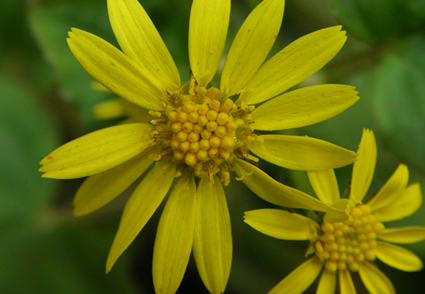Abstract
Sinosenecio qii (Asteraceae, Senecioneae) was described on the basis of a fruiting plant from Jianghua county in southern Hunan province, China. This species has been imperfectly known because of the scantiness of material. Based on the results of our careful observations of the morphological characters of living plants within a population of this species at its type locality and the examination of its chromosome number, here we determine that S. qii is related to S. globiger in having epappose and glabrous achenes, polar and radial anther endothecial cell wall thickenings and a chromosome number of 2n = 48, but it is distinctive in having scapiform (vs. leafy) stems with only radical (vs. radical and cauline) leaves subentire (vs. shallowly 3–5-lobed), and fewer ray florets (8 vs. 13). The morphological description of S. qii is amended.
References
- Bachman, S., Moat, J., Hill, A.W., Torre, J. de & Scott, B. (2011) Supporting red list threat assessments with GeoCAT: geospatial conservation assessment tool. ZooKeys 150: 117–126. https://doi.org/10.3897/zookeys.150.2109
- Chang, C.C. (1941) Some new and imperfectly known species of Compositae. Sunyatsenia 6: 17–25.
- Chen, Y.L., Liu, Y., Yang, Q.E., Nordenstam, B. & Jeffrey, C. (2011) Sinosenecio B. Nordenstam. In: Wu, Z.Y., Raven, P.H. & Hong, D.Y. (Eds.) Flora of China, vol. 20–21. Science Press, Beijing, pp. 464–481.
- Chen, B., Liu, Y., Luo, J.X., Wang, Q. & Yang, Q.E. (2022) Sinosenecio jiuzhaigouensis (Asteraceae, Senecioneae), a new species from Sichuan, China. Phytotaxa 544 (3): 289–294. https://doi.org/10.11646/phytotaxa.544.3.3
- Cummins, H.A. (1908) Senecio homogyniphyllus (“homogyniphylla”). In: III.–Decades kewensis plantarum novarum in Herbario Horti Regii conservatatum. Decades XLV–XLVI. Bulletin of Miscellaneous Information, Royal Botanic Gardens, Kew 1908: 17. https://doi.org/10.2307/4111775
- IUCN (2012) IUCN Red List Categories and Criteria: Version 3.1. Second edition. Gland, Switzerland and Cambridge, UK, 32 pp.
- Liu, Y. (2010) Systematics of the genus Sinosenecio B. Nord. (Asteraceae). Ph.D. thesis, Institute of Botany, Chinese Academy of Sciences, Beijing, 277 pp.
- Liu, Y. & Yang, Q.E. (201la) Cytology and its systematic implications in Sinosenecio (Senecioneae-Asteraceae) and two closely related genera. Plant Systematics and Evolution 291: 7–24. https://doi.org/10.1007/s00606-010-0365-3
- Liu, Y. & Yang, Q.E. (2011b) Floral micromorphology and its systematic implications in the genus Sinosenecio (Senecioneae-Asteraceae). Plant Systematics and Evolution 291: 243–256. https://doi.org/10.1007/s00606-010-0385-z
- Liu, Y. & Yang, Q.E. (2012) Sinosenecio jiangxiensis (Asteraceae), a new species from Jiangxi, China. Botanical Studies 53: 401–414.
- Liu, Y., Xu, Y. & Yang, Q.E. (2019) Sinosenecio peltatus (Asteraceae, Senecioneae), a remarkably distinctive new species from Guangdong, China. Phytotaxa 406 (3): 206–212. https://doi.org/10.11646/phytotaxa.406.3.7
- Liu, S.W. & He, T.N. (= Ho, T.N.) (2005) Two new species of Sinosenecio (Asteraceae) from China. In: Ling, Y.R., Ren, H., Liang, C.Y., He, M.J. & Mei, Q.X. (Eds.) International Symposium on Artemisia L. and its allies, Compositae–Systematics, Resource and Economic Uses. Science Education Publishing Company, Hongkong, pp. 185–187.
- Nordenstam, B. (1978) Taxonomic studies on the tribe Senecioneae (Compositae). Opera Botanica 44: 1–84.
- Peng, J.Y., Zhang, D.G., Deng, T., Huang, X.H., Chen, J.T., Meng, Y., Wang, Y. & Zhou, Q. (2022) Sinosenecio yangii (Asteraceae), a new species from Guizhou, China. PhytoKeys 210: 1–13. https://doi.org/10.3897/phytokeys.210.89480
- Su, X.J., Fei, W.Q., Zhao, D., Liu, Y. & Yang, Q.E. (2023) Sinosenecio minshanicus (Asteraceae, Senecioneae), a new species from south-eastern Gansu and northern Sichuan, China. PhytoKeys 218: 79–91. https://doi.org/10.3897/phytokeys.218.97475
- Su, X.J., Fei, W.Q., Zhao, D., Liu, Y. & Yang, Q.E. (2023) Sinosenecio pingwuensis (Asteraceae, Senecioneae), a new species from northern Sichuan, China. PhytoKeys 218: 109–116. https://doi.org/10.3897/phytokeys.218.97475
- Zou, C.Y., Liu, Y. & Liu, Y. (2020) Sinosenecio ovatifolius (Asteraceae), a new species from Guangxi, China. Phytotaxa 460 (2): 149–159. https://doi.org/10.11646/phytotaxa.460.2.5


